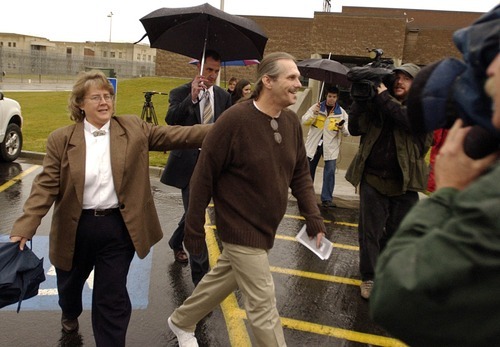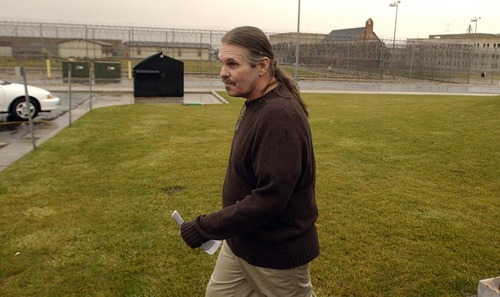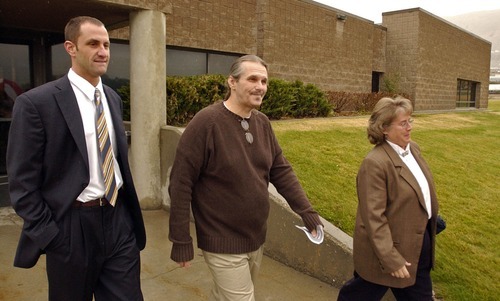This is an archived article that was published on sltrib.com in 2012, and information in the article may be outdated. It is provided only for personal research purposes and may not be reprinted.
Bruce Dallas Goodman spent 19 years in prison for murder. Harry Miller served 4½ years for a robbery. Both men were wrongfully convicted, but were freed only after spending years in a Utah prison.
In both cases, mistaken witness identification played a part.
"That's when a witness comes up and testifies that someone did it, but they were wrong," said Liz Fasse, an attorney with the Rocky Mountain Innocence Center (RMIC). "They made a mistake."
Goodman, Miller, and two other Utahns are included in the new National Registry of Exonerations, which lists detailed information on wrongful convictions in the past 23 years. Of all cases in the registry, 43 percent list mistaken witness identification as a contributing factor.
The largest known database of its kind, the registry effort began eight years ago when University of Michigan law professor Samuel Gross wrote a report on U.S. exonerations that included 340 already documented cases.
"I realized we were missing others because there wasn't any central location where people could report and collect, then retrieve information about exonerations," Gross said.
In the following years, Gross hoped someone would pick up where he left off and create a database he could use. But no one did.
Gross decided to take up the task, which became a joint project between the University of Michigan Law School and the Center on Wrongful Convictions at the Northwestern University School of Law.
After nearly three years of work, the registry launched in May. It includes detailed information of exoneration cases from January 1989 to February 2012. Details include where the crime happened, the type of crime, dates of sentencing, conviction and date of exoneration.
The numbers of cases in the registry, however, has already changed since the data was made public. The registry began with 873 cases in February. It is now at 904 cases.
That's because new cases that meet the criteria can be added continuously through the registry website.
"My guess is that the data will be up pretty close to a 1,000 cases or above by the end of the year," Gross said.
Case information came from a variety of sources. About 150 to 200 cases came from files at the Center on Wrongful Convictions at Northwestern. Gross said the project focused on 1989 as the starting point because that is when DNA exonerations first began.
The registry creators say having a database that collects a large range of exonerations will help shed light on the causes of false convictions, the types of cases in which they occur, how to prevent them from happening and how to mitigate the damages.
"The most valuable and important work is to learn from mistakes that we have made to avoid making similar ones in the future," Gross said.
Legal staff at the Innocence Center agree with Gross. Fasse said members of organizations like the RMIC — which examines innocence claims by prisoners in Utah, Nevada, and Wyoming — will be able to use the registry as a tool to advocate for policy changes.
"Why this is so great is that it allows us looking back to understand what are the factors that lead to wrongful convictions, and going forward lets us know what policy improvements we need to make in the criminal system," Fasse said. "Looking forward we need to figure out how we can make improvements that will prevent wrongful convictions."
Both Miller and Goodman were cases handled by the RMIC. Fasse said undoubtedly there are hundreds, if not thousands, of innocent people in prison. "We are just not able to get to them," she said.
Creators of the registry say the data isn't all-inclusive because of all the unknown and unreported cases, and there are others that don't fit the registry's criteria.
Among the cases that don't fit are group exonerations, which are the product of scandals where police officers systematically planted guns and drugs and framed numbers of innocent defendants for crimes that never occurred.
There are 1,170 such defendants referred to in a report accompanying the registry data. Gross said he was surprised to find that there were so many group exonerations.
Online • The National Registry of Exonerations
O exonerationregistry.org. —
By the numbers
51
Percent of wrongful convictions nationwide involved perjury or false accusation
43
Percent of those convictions involved mistaken eyewitness identification
42
Percent of wrongful convictions involve official misconduct
Source: National Registry of Exonerations —
A snapshot of the 873 exonerated defendants
93 percent are men, 7 percent are women
50 percent are black, 38 percent white, 11 percent Latino and 2 percent Native American or Asian
37 percent were exonerated with the help of DNA evidence; 63 percent without DNA
As a group, they spent more than 10,000 years in prison — an average of more than 11 years each.
Since 2000, exonerations have averaged 52 a year — one a week — 40 percent of which include DNA evidence.
Source: National Registry of Exonerations









